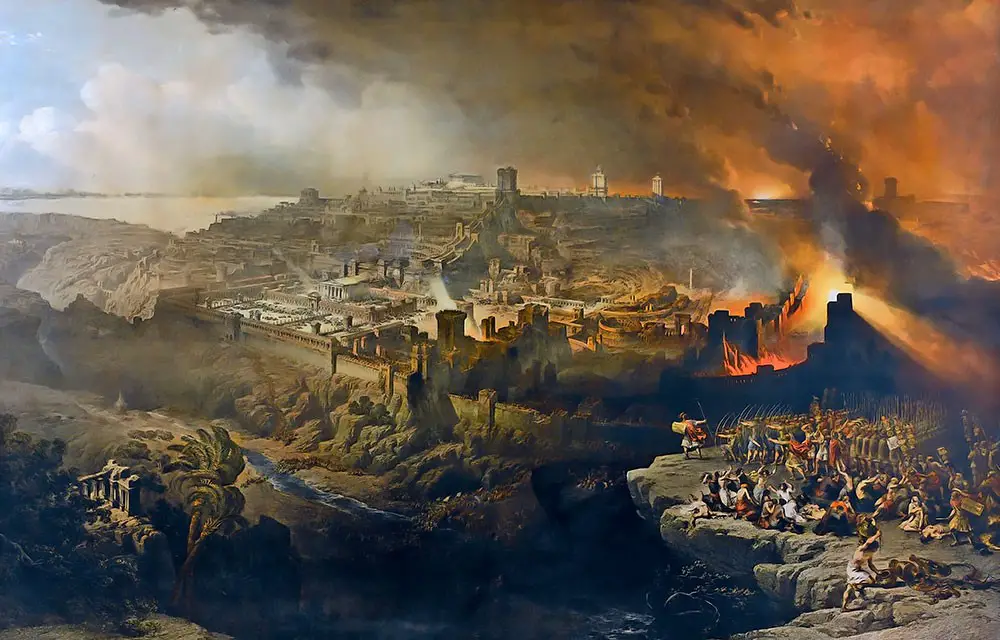In the New Testament, the Lord Jesus proclaimed the fate of the temple in Jerusalem with these famous words:
“And His disciples came to shew Him the buildings of the temple. And He answering, said to them: Do you see all these things? Amen, I say to you, there shall not be left here a stone upon a stone that shall not be thrown down. “
 lavius Claudius Iulianus, was a Roman Emperor of the Constantinian dynasty from 361–363 A.D. He was the last pagan Roman Emperor and tried to promote the Roman religious traditions of earlier centuries as a means of slowing the spread of Christianity. Iulianus had not always been a zealous pagan, and apparently, Arianism had been forced upon him as a child by his cousin Constantinus II, who had rejected paganism and would not tolerate a pagan relative. As attested in private letters between Iulianus and the rhetorician Libanius, he felt an urge to “react violently against the Christian teaching that he had received in a lonely and miserable childhood.”
lavius Claudius Iulianus, was a Roman Emperor of the Constantinian dynasty from 361–363 A.D. He was the last pagan Roman Emperor and tried to promote the Roman religious traditions of earlier centuries as a means of slowing the spread of Christianity. Iulianus had not always been a zealous pagan, and apparently, Arianism had been forced upon him as a child by his cousin Constantinus II, who had rejected paganism and would not tolerate a pagan relative. As attested in private letters between Iulianus and the rhetorician Libanius, he felt an urge to “react violently against the Christian teaching that he had received in a lonely and miserable childhood.”
Iulianus’ conversion from Arianism to Hellenism had led him to devote his life to protecting and restoring the fame and security of this tradition. His passion and strongly religious temperament only increased his contempt for any doctrine derived from the Christian religion, and so he earned himself the famous title which he would be remembered for by Christians throughout history, namely “Julian the Apostate.”
The Tolerance Edict
In February of 362, Julian promulgated an edict to guarantee freedom of religion. This edict proclaimed that all religions were equal in front of the Law and that the Roman Empire had to return to its original religious eclecticism, according to which the Roman State did not impose any religion on its provinces.
Though liberal and tolerant as it sounds, Julian’s new edict was at least partially designed to harass and undermine the ability of Christians to organise any resistance to the re-establishment of pagan acceptance in the empire. The Tolerance Edict decreed the reopening of pagan temples, the restitution of alienated temple properties, and called back Christian bishops that were exiled by church edicts. This last act of mercy was largely seen as an attempt by Julian to widen a schism between different Christian sects, in an attempt to further weakening the Christian movement.
A journey to Jerusalem
In 363, Julian stopped by the ruins of the Second Temple in Jerusalem on his way to Persia. The Jewish Temple had been destroyed by Roman legions under Titus in 70 A.D. and had laid in ruins ever since.
With the words of Christ ringing in his ears, Julian might have noticed that there were still a few stones left upon stones among the temple ruins, and suddenly a new idea was emerging in his restless emperor heart: He could have the temple rebuilt! This would fit perfectly into his tolerant Edict, with both fostering religions other than Christianity and undermining the very words of Christ. And so, to the great excitement and unexpectedness of the Jews, Julian ordered the Temple to be rebuilt.
Going back to St Matthew
There’s a quite famous Bible commentary from 1859, called “Haydock Bible Commentary” commenting on the verses from the Gospel according to St Matthew. There is found a historical account from 363 A.D., when Julian, together with the Jews tried to rebuild the temple, going against what Jesus said in the Gospel of Matthew. According to the account, a remarkable event took place. The account is transcribed below:
Haydock Bible Commentary on St Matthew Chap 24, verse 2:
“Julian the apostate, wishing to falsify the predictions of Daniel and of Jesus Christ, attempted to rebuild the temple. For this purpose, he assembled the chief among the Jews, and asking them why they neglected the prescribed sacrifices, was answered, that they could not offer any where else but in the temple of Jerusalem. Upon this he ordered them to return to Jerusalem, to rebuild their temple, and restore their ancient worship, promising them his concurrence in carrying on the work. This filled the Jews with inexpressible joy. Hence flocking to Jerusalem, they began with scorn and triumph to insult over the Christians.
Contributions came in from all parts. The Jewish women stripped themselves of their most costly ornaments. The emperor opened his treasures to furnish every thing necessary for the building. The most able workmen were convened from all parts; persons of the greatest distinction were appointed to direct the work; and the emperor’s friend, Alipius, was set over the whole, with orders to carry on the work without ceasing, and to spare no expense. All materials were laid in to an immense quantity. The Jews of both sexes bore a share in the labour; the women helping to dig the ground, and carry away the rubbish in their aprons and gowns. It is even said that the Jews appointed some pick-axes, spades, and baskets, to be made of silver, for the honour of the work.
Till this time the foundations and some ruins of the walls had remained, as appears from St. Cyril, in his catechism xv. n. 15, and Eusebius, Dem. Evang. lib. viii. p. 406. These ruins the Jews first demolished with their own hands, thus concurring to the accomplishment of our Saviour’s prediction.
They next began to dig a new foundation, in which many thousands were employed. But what they had thrown up in the day, was, by repeated earthquakes, the night following cast back again into the trench. When Alipius the next day was earnestly pressing on the work, with the assistance of the governor of the province, there issued, says Ammianus Marcellinus, such horrible balls of fire out of the earth near the foundations, as to render the place inaccessible from time to time to the scorched workmen.
And the victorious element continuing in this manner obstinately bent, as it were, to drive them to a distance, Alipius, thought proper to abandon, though reluctantly, the enterprise. This great event happened in the beginning of the year 363, and with many very astonishing circumstances is recorded both by Jews and Christians.
See the proofs and a much fuller account of this astonishing event, which all the ancient fathers describe as indubitable, in Alban Butler’s life of St. Cyril of Jerusalem, March 18th. Thus they so completely destroyed whatever remained of the ancient temple, that there was not left one stone upon another; nor were they permitted by heaven even to begin the new one. (Maldonatus)”
Other explanations
Not everyone is willing to accept an explanation of divine intervention. The failure to rebuild the Temple has by some been ascribed to an earthquake, common in the region, and to the Jews’ ambivalence about the project. Sabotage has also been proposed as a possibility, as well as an accidental fire. Still, divine intervention has been the common view among Christian historians of the time and even after.
Julian did live to hear about the disastrous events in Jerusalem, though it was one of the last things he experienced in this life. Libanius states that Julian was assassinated shortly after by a Christian who was one of his own soldiers; though this charge is not held by Ammianus Marcellinus or other contemporary historians. Julian was succeeded by the short-lived Emperor Jovian, who ruled until 364 A.D.
His last words
There are reports that Julian’s dying words were: “Vicisti, Galilaee” (You have won, Galilean). This is considered to be from an apocryphal source and is presumed to express his recognition that, with his death, Christianity would become the Empire’s state religion.
Julian’s anti-Christian measures did not survive, nor did they have much effect on slowing down the rapid spread of the Christian religion throughout the Roman Empire and beyond. Julian’s own Hellenist high priest urged pagans to imitate Christian charity, seeing how it was a most effective strategy to recruit new followers and spread its influences into people’s hearts and culture. To the Romans, it was obviously Christian charity that won the support and gratitude of the people.
What to make of it all
Whether you believe in the Haycock account, where the failed attempt to rebuild the Jewish Temple was attributed to divine intervention, or whether you remain sceptical to all of it, is up to you.
What cannot be ignored, however, is that through this event, Christ’s prediction came true in a very literal way. Despite the emperor’s attempt to rebuild, his decree to do this led the Jews to demolish the last walls of the construction, with the intention
of rebuilding it. This caused the last remaining parts of the temple ruins to be completely destroyed, not even a stone upon a stone. It’s just another example of how fascinating history can be.

Homeschooling mum, musician and bookworm dwelling on a small island in the Baltic Sea. I enjoy diving into history when I can, to learn where it has been altered or concealed and to ponder upon why it has been done.





